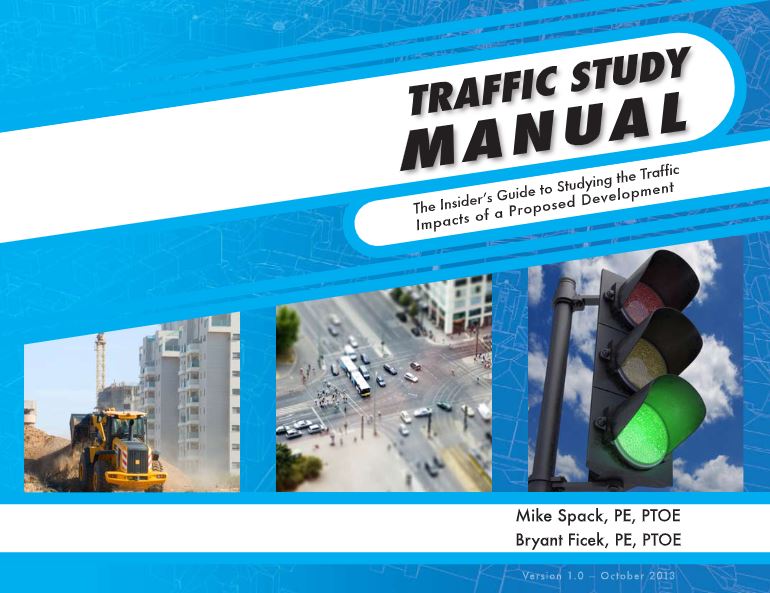
Mike Spack and Bryant Ficek have literally written a book about Traffic Impact Studies and the process from authorization to final study. We present the information we wish we had when starting our careers and hopefully have tips and refreshers that even experienced traffic engineers will find useful. This series presents the basic steps of completing a Traffic Impact Study from their book.
A common mistake a young engineer (or even us seasoned engineers) can make is to go off by herself to prepare the whole traffic study from start to finish. Several assumptions are necessary for elements like traffic forecasting and trip distribution. Although we have industry standard methods for getting us into the relative ballpark, altering one or more assumptions will change the results and potentially alter the findings/recommendations.
The most efficient process for your study is to, therefore, get agreement on those assumptions at the beginning to minimize changes later. That is the purpose of this task – to collaborate with the agencies that will be reviewing the finished traffic study, so you don’t get a surprise later. Surprises, in this case, could mean having to alter a key piece of the traffic study; thus, blowing your budget, making your client mad, and not impressing your boss.
We consider coordinating with the reviewing agencies the first task in preparing your traffic study and potentially one completed even earlier with the development of the scope and fee for your proposal. If possible, it’s best to confirm your assumptions with all the engineers who will be reviewing your study. The goal is to gain agreement on the basic analysis inputs and learn of any specific concerns.
This process assumes you are hired by the private development team directly to prepare the traffic study for their development. Sometimes, a city will hire the consultant directly to complete the traffic study. While this process is still relevant, the collaboration with the agencies will likely be streamlined, with more details addressed as part of preparing a proposal.
We typically try to give ourselves a week to get a response and discuss a project with each agency. Everyone is busy, so don’t assume you can discuss a project immediately.
In our view, the only reasons not to collaborate are:
- your client doesn’t want you to do so for some reason, such as confidentiality, or
- your deadline is so tight that you don’t have an extra week that collaboration on the assumptions might take.
If you find yourself in a situation where a week means missing your deadline, let your client know immediately. They need to understand that you’ll have to vary from your standard collaborative process, which will likely result in more comments and revisions at the end of the process.
Initial Contact
After ensuring you have the time in your schedule, confirm your client is amenable to your talking with the appropriate agencies. You may need to explain the benefits of collaborating; basically a smoother and quicker review process. You should also find out if your client spoke and shared information with any agency staff. Having this background will ensure you aren’t unpleasantly surprised by subsequent conversations with the government engineers.
Once you have permission from your client, call the city engineer or administrator. The purposes of your call are:
- Introduce yourself. Getting to know other engineers will help your career beyond one individual project – but that’s another manual.
- Introduce the project. If your contact hasn’t discussed the project yet, explain that you want to collaborate on the scope of the study and the underlying assumptions. Have a sketch site plan ready to email them and offer to send it while you’re on the phone.
- Find out if she’ll be the main reviewer of the traffic study. If not, find out who will be the technical reviewer – consultant, assistant city engineer or city traffic engineer.
- Ask if she thinks you should involve county or state agency personnel in the traffic study process. If yes, then ask who the appropriate contacts are for each agency.
- Get buy-in on a collaborative process.
- Get contact information, such as email addresses and phone numbers.
- Mention you will send a follow-up email with the basic assumptions and a rough schedule.
If appropriate for the project, contact the county and state staff next. A part of each phone call is to get the email addresses of your key contacts for your follow-up email.
We need to emphasize this point – ensure you’re working with the right people. It does little good to get agreement from one agency staff member, only to have your work questioned by her consultant or a different staff member. We’ve been in this situation, and know that frustration.
You should also be documenting your phone calls for later reference if needed. A simple word doc will do the trick. However, we find the best method of documentation is your follow-up email.
Follow-Up Email
We recommend confirming important details with emails because they provide clear documentation and can be easily referenced by all involved parties. Our initial list of ten topics to cover in your email to the reviewer/s are:
- Reintroduce yourself and mention your earlier phone call/s.
- Provide a brief description of your development, including:
- Location map
- Concept plan highlighting the proposed access points
- Anticipated build-out year
- Phasing plan if your development has two or more stages
- Size of your development, such as square footage or dwelling units
- Provide a map with the intersections and corridors you propose to study.
- Request the traffic signal timing plans if they have control over the traffic signals at any of your study intersections. This request may need to be separate to other individuals depending on the agency with jurisdiction and how they operate and maintain their traffic signals.
- Ask about or confirm other proposed development and roadway projects planned within your study area to include for background traffic growth.
- List the study periods you plan to study (such as daily, a.m. peak hour, school p.m. peak hour, p.m. peak hour, Saturday midday peak hour, etc.).
- List your proposed analysis years.
- List the methodology/software you’ll use for your analyses.
- Provide your schedule and ask about their typical review process and its associated timeline (for instance, how much time will they need to review your traffic study).
- Thank them for their time and ask them to confirm these details or provide comments on potential changes by a specific date. Again, we feel one week is appropriate.
A straightforward email could transmit the above information. In some cases, a PDF with several pages combined may be more appropriate to convey all this information. To formalize the PDF, you could also create a technical memorandum. Whatever your format, a template with key phrases and the outline of information could help expedite the process for you. Be careful with templates or copying the email from a previous project to ensure you remove old nonrelevant information and references to older projects. A checklist of key items may be more appropriate with a new email created for each project.
If the one or more people you’re trying to work with does not or can’t respond in a timely fashion, don’t stress out about it. Your email documentation shows you tried if it comes up later. You can thank them for their time and let them know you look forward to collaborating once you submit the draft traffic study. Collaboration is the best method, but each project still has a deadline to meet. Don’t let the ideal process sabotage your schedule.
Other information your follow-up email could contain includes:
- Asking if they have policies, ordinances, traffic impact fees and standards related to traffic studies. If you found them with your online research, confirm you have current information.
- Providing a table disclosing the estimated traffic generation for your development. Include any kinds of reductions such as internal trips, pass-by trips, diverted trips or reductions for being multi-modal.
- Providing a map showing the distribution pattern the site’s traffic will use.
- Documenting how you’ll increase the existing traffic counts to your future no-build scenario traffic counts.
Be careful with Item A on the list. Even though planners who are not licensed engineers prepare many traffic studies, you should check with your state’s licensing board to be safe. A few jurisdictions, including the Wisconsin DOT, require a licensed civil engineer (PE) to sign and stamp the traffic study. The Minneapolis suburb, Edina, requires the preparer to have the Professional Traffic Operations Engineer® certification (PTOE). San Diego County, California requires they certify the preparer and attend a bi-annual training session.
For those projects with several agency reviewers, it’s your decision if you want to send a separate email to each reviewer or send the same email to all of the reviewers. We like the collaborative approach of including all the reviewers on the same email string (for instance the city, county, and state traffic engineers). Email strings allow everyone to see the correspondence and hopefully avoid conflicting guidance. Generally, one agency is the lead, so everyone knows who has the final say. In that case, you could direct your email to them and CC the others.
For larger-scale traffic studies that involve the impact on several levels of government (for instance county, state and local roads), it may be more efficient to have a task force meeting to specify the traffic study scope and assumptions. A joint meeting will build agreement on the assumptions and the scope of the traffic study in a situation where individual emails could end up being contradictory. These types of meetings are usually best led by the city engineer because they will typically better understand the potential politics behind any project.
This is a multipart series. Check out the other articles in this series.
- Traffic Impact Study Process – Part 2: Preliminary Assessment
- Traffic Impact Study Process – Part 3: Document Existing Conditions
- Traffic Impact Study Process – Part 4: Traffic Data Collection
- Traffic Impact Study Process – Part 5: Prepare Traffic Forecasts
- Traffic Impact Study Process – Part 6: Perform Capacity Analysis
- Traffic Impact Study Process – Part 7: Determine Necessary Improvements

